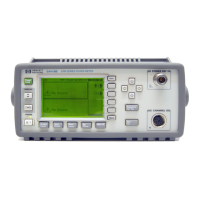prog.book : chapter1.fm 43 Mon Feb 15 09:24:37 1999
Power Meter Remote Operation
Using Frequency Dependent Offset Tables
HP E4418B/E4419B Programming Guide 1-43
Note The legal frequency suffix multipliers are any of the IEEE suffix
multipliers, for example, KHZ, MHZ and GHZ. If no units are
specified the power meter assumes the data is Hz.
PCT is the only legal unit for offset factors and can be omitted.
The frequency and offset data must be within range. Refer to the
individual commands in Chapter 4 for their specified ranges.
Any offset values entered into the table should exclude the effect of
the sensor. Characterisation of the test setup independently of the
sensor allows the same table to be used with any sensor.
Ensure that the frequency points you use cover the frequency
range of the signals you want to measure. If you measure a signal
with a frequency outside the frequency range defined in the
frequency dependent offset table, then the power meter uses the
highest or lowest frequency point in the table to calculate the
offset.
To make subsequent editing of a frequency dependent offset table
simpler, it is recommended that you retain a copy of your data in a
program.
Listing the Frequency Dependent Offset Table Names
To list the frequency dependent offset tables currently stored in the power
meter, use the following command:
MEMory:CATalog:TABLe?
Note that all tables are listed; including sensor calibration tables.
The power meter returns the data in the form of two numeric parameters
and a string list representing all stored tables.
• <numeric_value>,<numeric_value>{,<string>}
The first numeric parameter indicates the amount of memory, in
bytes, used for storage of tables. The second parameter indicates
the memory, in bytes, available for tables.

